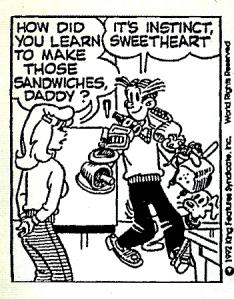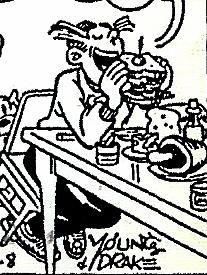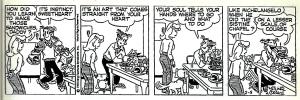In an article that I wrote for the Mensa Bulletin back in 2006, I described a class of words and terms that have entered the English lexicon from cartoons that I call “cartoonyms.” Among those elite terms are “gerrymander,” “McCarthyism,” and “security blanket.” There are about thirty more cartoonyms that can be found in any number of dictionaries, and all of them have interesting etymologies. About that, H. L. Mencken once said, “Comic strip artists have been unsurpassed as diligent coiners of neologisms.” That may be an exaggeration, or maybe it was truer during the 1920s when Mencken was writing, but cartoonists have contributed their share of new words to English—some have stayed. Other terms like “23 skidoo” have effectively passed into oblivion. “Dagwood,” an adjective that has stayed in the English language and is used to describe a rather tall sandwich, laden with ingredients comes from Chic Young’s cartoon Blondie.
A Dagwood sandwich is one that is stacked high with various ingredients and is so tall that a normal person would not be able to take a whole vertical bite of it. Typically, Dagwood, the character, is depicted leaving the refrigerator with ingredients in his hands and balanced on both arms as he goes to the dining room table to begin constructing the sandwich. He is often shown with the tall sandwich in his hands and a big smile on his face as he gets ready to eat the thing, but he is never shown actually eating it. That construction, drawing the impossible, is an aspect of cartooning that is acceptable in sequential drawings like cartoon strips, but is less acceptable in other media like television and movies. Consumers expect information to be missing between panels of a strip, but there is an expectation that nothing is missing from motion pictures.
First of all, the method Dagwood uses to transfer the ingredients from the refrigerator to the table is pretty incredible. The cartoon reader is not privy to how Dagwood balances all of the ingredients on his arms and shoulders. The reader only sees him strut confidently to the table in preparation for the construction project. In the following cartoon, Cookie, Dagwood’s daughter asks her father about his tradition of making sandwiches. She stands with her hands behind her back as her father walks the ingredients to the table, unconcerned about a mishap or mess. She has obviously witnessed this process many times before.

Following the construction of the massive comestible, the reader is treated to a smiling Dagwood reveling in the prospect of consuming his creation. Again, the reader sees that the sandwich is taller than anything that a normal human, Dagwood included, can possibly bite from top to bottom–as sandwiches are normally eaten. He is relishing (pun intended) the prospect of eating that sandwich so much that he is leaning in so far that his chair is tipped forward. And, while this strip ends with him preparing to take his first bite, other Blondie strips depict Dagwood wiping his mouth after he has presumably finished eating the sandwich (the sandwich is no longer in the tableau, and there are crumbs on the plate). Again, the reader is not privy to the knowledge of how the character consumes the sandwich; the reader only knows that it is gone.

Ed Hall, a syndicated political cartoonist from Jacksonville, Florida who draws for the Baker County Press, theorizes that the best cartoons show what happens just before an action or just after an action but do not show the action itself. Therefore, Dagwood will always be depicted carrying the ingredients to the table, but will not be depicted putting the ingredients on his arms and shoulders. As well, he will be shown just before he eats the sandwich and when the sandwich is gone and he is wiping around his mouth, but he will never be shown actually eating it. How Dagwood eats the sandwich and disarms the ingredients are among the many mysteries of the cartoon strip world, mysteries that are best kept secret in order to maintain that child-like faith that everything will turn out—if not always well, always humorously.
The two panels above are from a single cartoon strip that was published on February 8, 1992. Dagwood has been eating those sandwiches since 1930, and while you or I would probably grow to the size of a blimp if we were to eat those things, Dagwood has not gained an ounce in the over 83 years since the inception of the strip, and he will not gain an ounce over the next 83 years either (another mystery that is best left to comics). In case you were wondering, following is the entire strip of 2-8-1992.

In the movies or television, consumers might feel cheated if they were not shown how something happened; however, cartoon readers do not feel cheated, they feel treated to an amusing mystery of the cartoon storyteller’s art. May this one endure, and like Calvin’s stuffed tiger that comes to life and Snoopy sleeping while balanced on his doghouse, may many more come along to intrigue us.
